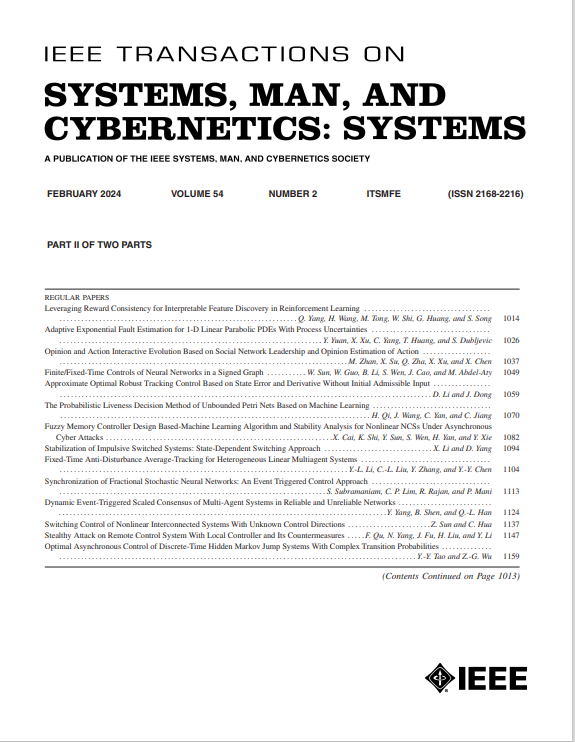UFAREX: A Universal Fully Autonomous Robust Expansionist Fuzzy System for Optimal Online Learning From Nonstationary Data Streams
IF 8.6
1区 计算机科学
Q1 AUTOMATION & CONTROL SYSTEMS
IEEE Transactions on Systems Man Cybernetics-Systems
Pub Date : 2024-09-26
DOI:10.1109/TSMC.2024.3454541
引用次数: 0
Abstract
Online intelligent knowledge extraction from real-world nonstationary data streams presents a multiobjective optimization challenge. Here, we characterize the learning process on a trajectory of global optimality to simultaneously satisfy six high-profile objectives: 1) optimum generalization for the best bias-variance tradeoff; 2) compactness of knowledgebase; 3) memory retention and stability-plasticity balance; 4) universality and full autonomy; 5) robustness against outliers, noise, and model uncertainty; and 6) active concept drift detection and adaptation. We propose a flexible Takagi-Sugeno (TS) fuzzy system, named UFAREX, that self-constructs and self-guards from scratch in a non-iterative sample-wise training scheme without storing data. Through quantification of various uncertainties, an adaptive prediction interval (API) is sequentially learned for each local dynamism to automatically capture the most accurate compact representation with a 95% confidence. This leads to the best linear unbiased estimation (BLUE) of local trends. To avoid catastrophic forgetting, API collaborates with trapezoidal membership functions (TMFs) to expand local boundaries with maximum plasticity and without distortive extrapolation. As a robust detection mechanism, API also pinpoints regions in conflict (RIC) where concept drifts and outliers are actively expressed w.r.t. time of occurrence, location, type, and severity. This establishes a single-sample online active concept drift management with zero buffer latency for regression applications. No heuristic forgetting, pruning, splitting, merging, and weighting mechanisms are exercised to prevent human intervention and render universality. UFAREX was comparatively tested on four real-world benchmarks. It stands out as an autonomous system geared for adaptive modeling, time-series forecasting, anomaly monitoring, and robust fault detection and diagnosis.UFAREX:从非稳态数据流中优化在线学习的通用全自主鲁棒扩展模糊系统
从现实世界的非稳态数据流中进行在线智能知识提取是一项多目标优化挑战。在这里,我们描述了全局最优轨迹上的学习过程,以同时满足六个备受瞩目的目标:1) 最佳泛化,实现最佳偏差-方差权衡;2) 知识库的紧凑性;3) 记忆保持和稳定性-可塑性平衡;4) 通用性和完全自主性;5) 对异常值、噪声和模型不确定性的鲁棒性;以及 6) 主动概念漂移检测和适应。我们提出了一种灵活的高木-菅野(TS)模糊系统,并将其命名为 UFAREX,它能在不存储数据的情况下,通过非迭代的样本训练方案从头开始自我构建和自我保护。通过量化各种不确定性,为每个局部动态依次学习自适应预测区间(API),以 95% 的置信度自动捕捉最准确的紧凑表示。这样就能对局部趋势进行最佳线性无偏估计(BLUE)。为避免灾难性遗忘,API 与梯形成员函数 (TMF) 合作,以最大可塑性扩展局部边界,而不会出现扭曲外推。作为一种稳健的检测机制,API 还能精确定位冲突区域 (RIC),在这些区域中,概念漂移和异常值在发生时间、位置、类型和严重程度方面都有积极表现。这就为回归应用建立了零缓冲延迟的单样本在线主动概念漂移管理。为防止人为干预和实现普遍性,不使用启发式遗忘、剪枝、分割、合并和加权机制。UFAREX 在四个实际基准上进行了比较测试。它作为一个自主系统,在自适应建模、时间序列预测、异常监测以及稳健的故障检测和诊断方面表现突出。
本文章由计算机程序翻译,如有差异,请以英文原文为准。
求助全文
约1分钟内获得全文
求助全文
来源期刊

IEEE Transactions on Systems Man Cybernetics-Systems
AUTOMATION & CONTROL SYSTEMS-COMPUTER SCIENCE, CYBERNETICS
CiteScore
18.50
自引率
11.50%
发文量
812
审稿时长
6 months
期刊介绍:
The IEEE Transactions on Systems, Man, and Cybernetics: Systems encompasses the fields of systems engineering, covering issue formulation, analysis, and modeling throughout the systems engineering lifecycle phases. It addresses decision-making, issue interpretation, systems management, processes, and various methods such as optimization, modeling, and simulation in the development and deployment of large systems.
 求助内容:
求助内容: 应助结果提醒方式:
应助结果提醒方式:


